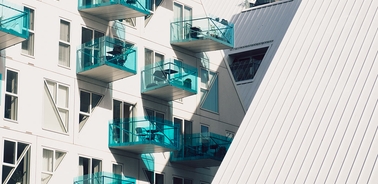- Home
- Our Purpose At Ie University
- Knowledge At Ie University
- A New Urban Experience
A New Urban Experience

The experience of observing the city from the windows, without being able to walk down its streets can and should make us think that a new urban reality is possible. In this new reality, social interaction is key. Cristina Mateo discusses some of the ways the new urban experience is helping bring people together.
by Cristina Mateo, Vice Dean of IE School of Architecture and Design.
The health of contemporary urbanites is measured by the quality of our interaction with the wider world, and for the foreseeable future, our cities are sick. For a few days now, when we go out, we only see people alone, wearing masks and gloves, avoiding all contact.
This is therefore the time to rethink our cities in an interdisciplinary way. From their design, cities have adapted to different epidemics by contributing through urban planning and architecture to what we’re now calling social distance, in order to avoid infectious risks. And today, with the COVID19 epidemic, there is already talk that public spaces are going to be designed with a much higher level of automation to avoid possible contagion: automatic doors, voice-activated lifts, non-contact switches and temperature controls, etc.
The loneliness epidemic
However, we must be aware that our cities have been suffering from another epidemic long before COVID19 , namely loneliness. This is something that particularly affects our elders, a collective we need to look after more than ever to prevent them from remaining confined, isolated and alone after the coronavirus lockdown.
Since the appearance of the virus, we have seen initiatives around the world to promote social interaction and end isolation, bringing people together, perhaps pointing to a new urban experience:
1. Urban diplomatic initiatives using iconic buildings as messengers of solidarity and support, as well as to educate and raise awareness
The Burj Khalifa in Dubai was lit up with the colors of the Spanish flag and a message displayed to thank health professionals, #GraciasProfesionalesSanitarios; Zaha Hadid's Sheikh Zayed Bridge and the HOK-designed ADNOC headquarters, both in Abu Dhabi, have followed initiatives by the Chinese government which was the first to use screens covering entire buildings to create powerful images of hope and solidarity.
2. More or less spontaneous and altruistic initiatives that seek to reproduce the feel-good effect of mass meetings that temporarily generate a sense of community.
Some cultural expressions of solidarity have gone viral: songs sung from balconies and terraces to cheer up the local population, as well as online events such as the #YoMeQuedoEnCasaFestival (a Spain-based stay-at-home music festival), with a lineup of more than 40 artists broadcasting concerts of up to one hour live on Instagram. Social networks are leading the way in solidarity-based creativity. On TikTok, teenagers are keeping themselves busy creating memes, while on Twitter, #HighRiskCovid19 is an aggregator of opinions from people in difficult situations, sharing their personal experiences.
3. Cooperation initiatives, whereby neighbors bring the local community together.
These include book exchanges and preparing and delivering food to homes (#YoTeCocino), coordinated through Twitter, as well as fitness classes in courtyards for residents of gated communities, to videos of doctors in Iran dancing to cheer up their patients, and of course, daily applauses around the world for health staff. All of them suggest a reawakening of the neighborhood spirit our grandparents who left the countryside for the city would have experienced, and that is now reproducing itself intergenerationally, between boomers, and from Generation X to Z.
A constructive spirit
The coronavirus pandemic is proving to be a time to practice hope and to think that when all this is over and we can go out again, hopefully we will do so to practice "the drift" of the Situationists, who like Guy Debord, sought to escape from daily routines and look at the city in a different way, which includes thinking about how we move around it and how we relate to each other, particularly the most vulnerable, our elders.
This means accessible public transportation, level sidewalks, shady benches to sit on, good street lighting, and public restrooms, which can encourage them to get out into the city and interact. The essence of the urban is social interaction. Everyone's. We must not forget that.